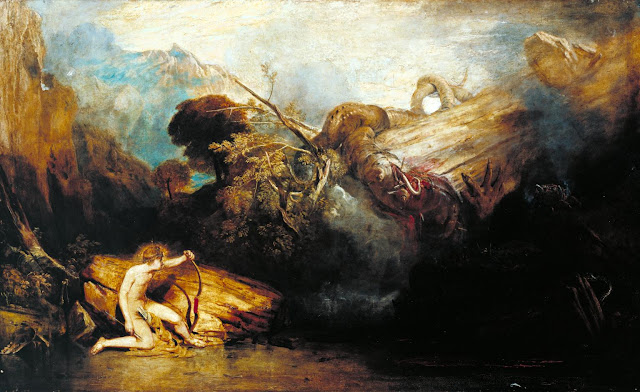 |
| Joseph Mallord William Turner Apollo and Python ca. 1811 oil on canvas Tate, London |
"Exhibited in 1811 with the following lines from Callimachus –
Envenom'd by thy darts, the monster coil'd
Portentous, horrible and vast his snake-like form:
Rent the huge portal of the rocky den
And in the throes of death he tore
His many wounds in one, while earth
Absorbing blacken'd with his gore."
 |
| John St John Long The Temptation of Christ in the Wilderness 1824 oil on panel Tate, London |
"Long's brief artistic career seems only to have spanned the 1820s. The majority of his pictures were biblical subjects. This example is an illustration of the first temptation in the wilderness when the Devil tries to tempt Christ into turning some stones into loaves of bread. By 1827 Long had set himself up as a 'doctor' specialising in the cure of consumption. In 1828 he was exposed as a quack, and following the death of two patients between 1830 and 1831, was found guilty of manslaughter. He managed to escape with a fine, and continued to practice as a doctor."
 |
| George Richmond Abel the Shepherd 1825 tempera on panel Tate, London |
"Richmond was the youngest of Blake's followers, known as the 'Ancients'. He first met Blake in 1824. Later that year he became a student at the Royal Academy. This was his first exhibited picture, shown at the Academy in 1825. It shows Abel, the son of Adam and Eve, who was described in Genesis as 'a keeper of sheep'."
 |
| William Etty Candaules King of Lydia shews his wife by stealth to Gyges as she goes to bed ca. 1830 oil on canvas Tate, London |
"Etty here subverts the language of neo-classical history painting. Instead of improving themes, Etty uses it for an erotic subject of voyeurism and vengeance. He emphasises colour and texture rather than outline, and treats physical beauty as the object of lust and deception. His picture typified the Romantic challenge to moral and pictorial conventions."
 |
| James Stephanoff Banquet of Henry VIII at York House with Cardinal Wolsey and Anne Boleyn 1832 watercolor Royal Collection, Windsor |
 |
| Henry Wallis Chatterton 1856 oil on canvas Tate, London |
"Thomas Chatterton was an 18th century poet, a Romantic figure whose melancholy temperament and early suicide captured the imagination of numerous artists and writers. . . . The painting alludes to the idea of the artist as a martyr of society through the Christ-like pose and the torn sheets of poetry on the floor. . . . Following the Pre-Raphaelite credo of truth to nature, Wallis attempted to recreate the attic room in Gray's Inn where Chatterton had killed himself. The model for the figure was the novelist George Meredith, then aged about 28. Two years later Wallis eloped with Meredith's wife, a daughter of the novelist Thomas Love Peacock."
 |
| William Lindsay Windus The Second Duchess before 1866 oil on panel Tate, London |
 |
| Frederick Walker The Old Gate ca. 1869 oil on canvas Tate, London |
"Walker shows the crumbling gate of Halsway Court at Crowcombe in Somerset, where he stayed in 1868-69. Using local people as models, he added figures to give the picture a narrative content. However, Walker deliberately let the narrative remain ambiguous, to encourage viewers to construct their own story."
 |
| Simeon Solomon A Youth relating Tales to Ladies 1870 oil on canvas Tate, London |
 |
| James Tissot The Ball on Shipboard ca. 1874 oil on canvas Tate, London |
"Tissot's paintings of fashionable Victorian social scenes were extremely popular and brought him celebrity and financial success. However, some critics complained that their lack of clear narrative and moral purpose cut across the grain of British art. John Ruskin described them as 'unhappy mere colour photographs of vulgar society.' Tissot certainly delighted in fashion and the mores of high society, as can be seen in this scene which shows men and women relaxing at an event thought to be the annual regatta at Cowes on the isle of Wight."
 |
| James Tissot Portsmouth Dockyard ca. 1877 oil on canvas Tate, London |
 |
| George Frederic Watts Sic Transit 1891-92 oil on canvas Tate, London |
 |
| Frederic Leighton And the Sea gave up the Dead which were in it 1892 oil on canvas Tate, London |
"This is one of the most dramatic and powerful works painted in the dark and solemn style of Leighton's late career. It was originally designed as one of eight roundels on the theme of the Apocalypse, intended to decorate the spandrel of the dome of St. Paul's Cathedral in London. The scheme was initiated by Alfred Stevens, but was abandoned when the original design was rejected as 'unsuitable for a Christian church.' The present, reduced version was commissioned by Henry Tate, for his new gallery of British art."
 |
| Robert Brough Fantaisie en Folie 1897 oil on canvas Tate, London |
"The title is best translated as 'Unbridled Fantasy'. The picture's misty brushwork and harmonious, neutral palette show the influence of Whistler, as does the reference to music. The woman's mysterious gesture suggests mood rather than narrative. The work was praised at home and abroad, where it was widely exhibited. A protege of Sargent, Brough built a successful practice as a portrait painter, but died young, aged 34, after a train accident. He seems to have regarded Fantaisie en Folie as his artistic testament, as he bequeathed it to the Tate Gallery."
– all quoted passages based on notes by curators at the Tate in London